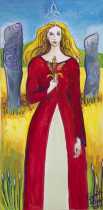
Arianrhod (ar i AN trod), Welsh Star Goddess of Reincarnation, is known as Silver Wheel, Silver Circle, High Fruitful Mother, and Sky Goddess. She is a primal figure of feminine power, a Celestial Mother Goddess who through her role as Goddess of Reincarnation, rules fertility and childbirth.
Arianrhod also rules arts, magic, and manifestation. As the Goddess of the Silver Wheel she is associated with spinning and weaving. With her wheel she magically weaves the tapestry of life.
Divinatory Meaning
Be in the open mind of the initiate who seeks truth of self and of others. Seek the knowledge of past lives and release the past. Connect with the collective consciousness of your ancestors. Allow rebirth and renewal.
Her Story
Arianrhod, the most powerful child of the great Mother Goddess, Don, was very beautiful, with extremely pale skin. She was a virgin goddess in the ancient meaning of the word virgin – a woman who is complete unto herself; a woman who needs no protection from a man. She enjoyed sexual freedom, with a distinct preference for mermen.
Her palace was found in the far North on the magical, rotating island of Caer Sidi, which probably means Revolving Castle, where she lived with her female attendants. The ancients believed that her domain and her castle, Caer Arianrhod, were in the Corona Borealis, the constellation of stars moving around the apparently motionless North Star. Legend tells us that poets and astrologers learned the wisdom of the stars at Caer Sidi.
She has also been known as the Silver Wheel that Descends into the Sea, which together with her preference for mermen and her son, Dylan, supports her strong association with the sea.
Caer Sidi is also known as Annwn, the Otherworld, land of the dead. People were brought there when they died. As Silver Wheel, Arianrhod was responsible for the souls of warriors who fell in battle. She gathered them aboard her ship, the Oar Wheel. and transported them to Emania, also know as Moonland. In the Northern sky, whirling around the enduring stability of the north star, Arianrhod presided over the fates of departed souls, nurturing their journeys between lives.
Things sacred to Arianrhod are the owl, the wolf, and the birch tree. The owl has long been associated with death, whereas the birch tree is the tree of new beginnings. To the Celts, the wolf was associated with the power of the moon.
She was sister to Gwydion, King Math's successor and student of the magical arts. She was also the mother of two sons, Llew, a Sun God, and Dylan, a God of the Sea. Their birth was a consequence of magic and trickery, a story recounted in the fourth branch of the Welsh collection of stories, known as The Mabinogion, dating back in their oral form to the 4th century BCE.
New fashions arrived and knowledge of fatherhood together with the idea of chaste virginity entered human consciousness. Arianrhod became enamored of the glamour of this fashion, yet with no intention or desire of practicing chastity.
Arianrhod's uncle, the magician King Math, was under a strange taboo which required him to keep his feet in the lap of a virgin whenever he was not actively engaged in battle. Gwydion suggested his sister Arianrhod for this role, with a secret intention of his own, and he set out for Caer Sidi to present the offer to Arianrhod.
During his stay with Arianrhod, Gwydion had a different suggestion for her: he proposed marriage. The true heir to the house of Don could only come through the female line and Gwydion wanted his seed to father that heir. But Arianrhod valued her position as an independent woman without need to be tied to a man and chose instead the excitement of court and the possibility of acquiring more magical powers herself.
Arianrhod journeyed with Gwydion to the castle of King Math, where the king demanded proof of her virginity: she had to step across a magical rod designed by Gwydion which caused her to birth two boys, products of liaisons with two different males, a merman and Gwydion. The first, whom Math named Dylan, fled to the sea and swam away. The second boy, unnoticed by all present, was scooped up by Gwydion, and raised in a magic forest.
Thus, through guile and trickery, Gwydion forced Arianrhod to bear what became known as his foster child.
When Arianrhod learned of this betrayal, she laid three curses on the boy. She denied the child a name or the right to bear arms – the right of Welsh mothers,which gives a clear indication of the ancient power of women. But Gwydion tricked Arianrhod into granting them. The third curse - “the boy shall have no wife of the race that is now on the earth,” Gwydion broke by creating a woman of flowers, Blodeuwedd, to be his son's wife.
Humiliated, defeated, and betrayed, Arianrhod spent the rest of her days at Caer Arianrhod. When the sea reclaimed the land, Arianrhod and her realm drowned and an epoch ended, but she lived in the hearts of her people for countless ages, nourishing their souls.
Arianrhod opens your heart to the flowing changes of the moon and the infinite possibilities of the stars.
Visit Judith's Etsy Shop to view and purchase her Celtic Goddess Oracle deck





















